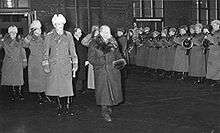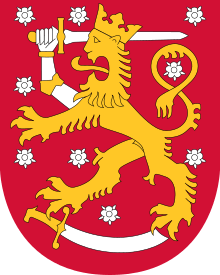Kyösti Kallio
Kyösti Kallio (Finnish pronunciation: [ˈkyø̯sti ˈkɑlːio]; 10 April 1873 – 19 December 1940) was a Finnish politician of the Agrarian League who served as the fourth President of Finland from 1937–1940. He was a prominent leader of the Agrarian League, and served as Prime Minister four times and Speaker of the Parliament six times.[3][4]
President[1] Kyösti Kallio | |
|---|---|
 | |
| 4th President of Finland | |
| In office 1 March 1937 – 19 December 1940 | |
| Prime Minister | Aimo Cajander Risto Ryti |
| Preceded by | P. E. Svinhufvud |
| Succeeded by | Risto Ryti |
| 8th Prime Minister of Finland[2] | |
| In office 7 October 1936 – 15 February 1937 | |
| President | P. E. Svinhufvud |
| Preceded by | Toivo M. Kivimäki |
| Succeeded by | Aimo Cajander |
| In office 16 August 1929 – 4 July 1930 | |
| President | Lauri K. Relander |
| Preceded by | Oskari Mantere |
| Succeeded by | P. E. Svinhufvud |
| In office 31 December 1925 – 13 December 1926 | |
| President | Lauri K. Relander |
| Preceded by | Antti Tulenheimo |
| Succeeded by | Väinö Tanner |
| In office 14 November 1922 – 18 January 1924 | |
| President | Kaarlo J. Ståhlberg |
| Preceded by | Aimo Cajander |
| Succeeded by | Aimo Cajander |
| Speaker of the Finnish Parliament | |
| In office 21 October 1930 – 8 October 1936 | |
| Preceded by | Juho Sunila |
| Succeeded by | Väinö Hakkila |
| In office 1 February 1929 – 16 August 1929 | |
| Preceded by | Paavo Virkkunen |
| Succeeded by | Paavo Virkkunen |
| In office 3 September 1927 – 31 January 1928 | |
| Preceded by | Paavo Virkkunen |
| Succeeded by | Paavo Virkkunen |
| In office 2 May 1924 – 31 March 1925 | |
| Preceded by | Paavo Virkkunen |
| Succeeded by | Wäinö Wuolijoki |
| In office 6 September 1922 – 14 November 1922 | |
| Preceded by | Wäinö Wuolijoki |
| Succeeded by | Wäinö Wuolijoki |
| In office 8 May 1920 – 29 March 1921 | |
| Preceded by | Lauri K. Relander |
| Succeeded by | Wäinö Wuolijoki |
| Personal details | |
| Born | 10 April 1873 Ylivieska, Grand Duchy of Finland, Russian Empire |
| Died | 19 December 1940 (aged 67) Helsinki, Finland |
| Nationality | Finnish |
| Political party | Agrarian |
| Spouse(s) | Kaisa Nivala |
| Children | 6 |
| Occupation | Farmer Bank clerk |
| Signature | |
Biography
Early life
Kyösti Kallio, originally Gustaf Kalliokangas (forename's Swedish pronunciation: [ˈɡɵ̂sːtav], surname's Finnish pronunciation: [ˈkɑlːioˌkɑŋːɑs]), was born in Ylivieska, Grand Duchy of Finland, which was an autonomous region of the Russian Empire at the time. His father was a farmer and a prominent local politician. Kyösti Kallio was educated in Oulu where he became acquainted with Santeri Alkio, author and future ideologue of the Agrarian League.
Start of career
Kallio entered into politics during the first Russification campaign of Finland as a member of the Young Finnish Party. He served in the Diet of Finland 1904–1906 as a member of the Estate of the Peasantry. He joined the newly founded Agrarian League in 1906 and became one of its most prominent leaders.
Finland gains independence
After the February Revolution of 1917 dethroned Tsar Nicholas II, the Russian provisional government tasked Vice Admiral Adrian Nepenin with overseeing the change of government in Finland. Nepenin started by inviting a handful of Finnish politicians to discuss the situation on March 17. Kallio represented the Agrarian League, and when the Finnish politicians the next day sent a delegation to Saint Petersburg to negotiate a cessation to the Russification campaign, Kallio was again a member. The delegation was successful, and Finland was permitted to assemble a fully parliamentary Senate. Kallio came to serve as Agrarian minister in the Senate of Oskari Tokoi, which took office March 26. Most of his time was spent trying to mediate the agrarian strikes and finding foodstuffs for the country, while the First World War raised the prices in Europe.
After the Tsar had been dethroned, the Finnish Parliament had to decide whether the highest authority in the country had passed on to the Russian Provisional Government, the Finnish Parliament or the Finnish Senate. The question led to serious strife between the right-wing and the left-wing elements of the Parliament. Kallio initially supported the socialists in demanding said power to the Parliament, but disapproved of their cooperation with Russian Bolsheviks and Mensheviks, and ultimately voted against the bill they had drafted. Nonetheless, the socialist proposal passed, which the Russian Provisional Government saw as an affront to their power, and Alexander Kerensky consequently dissolved the Parliament on September 8. Kallio and the Socialist Senators resigned from the Senate, which continued to operate under the leadership of E. N. Setälä.
After the October Revolution the bourgeoisie were willing to compromise and give the Parliament the highest authority fearing Bolshevik rule would spread to Finland. Setälä's Senate resigned immediately after the question was settled. Kallio was again named Agrarian Minister in the Senate of P. E. Svinhufvud whose first priority was to declare Finland independent. On December 4 the Senate introduced a declaration of independence to the Parliament, and the next day Kallio wrote a resolution, which the Parliament passed with votes 100–88.
Civil war
During the Civil War in Finland, Kallio hid in Red-dominated Helsinki, because he was at least nominally on the White side and therefore a "class enemy"; he formed a new senate (government) in Helsinki after German troops had defeated the Reds in the city. Afterwards he became a moderate peace-maker and disapproved of retaliation against the Reds.
Formation of the republic
During the debates over the form of the new state in 1918, Kallio resigned from the Senate because he supported a republic instead of constitutional monarchy. Eventually, the monarchist stand lost and he returned to the Cabinet to become Prime Minister. He was a reformist who emphasized education, settlement, and land reform. His greatest achievement was "Lex Kallio" in 1922, legislation allowing the state to buy land to encourage new settlements, and to let the former tenant farmers and other landless rural people buy small farms (see, for example, Seppo Zetterberg et al., ed., "Suomen historian pikkujättiläinen").
Supported prohibition
He supported Prohibition in Finland, and was dismayed when it was repealed in 1932.
Non-violent anti-communist
Kallio was an anti-communist, suppressing the Finnish Communist Party (SKP) in 1923, but he resorted to legislative methods. When the violent right-wing Lapua Movement asked him to become their leader, he refused and was then instead subjected to their death threats.
President

Kallio was elected president with the votes of a centrist (Agrarian and Progressive) and social democratic coalition, which wanted to ensure that President Svinhufvud would not be re-elected. Kallio took the role of a parliamentarian president and avoided use of his personal power.

On the eve of the Winter War, when Marshal Mannerheim once again threatened to resign from his post as chairman of Finland's Defence Council due to a schism with the cabinet, Kallio convinced him to stay. During the war Kallio resisted the idea of giving up any territory to the Soviet Union, but was forced to agree to sign the Moscow Peace Treaty in 1940. His health begun to fail – his right arm was paralyzed – and he was not active in the dealings with Germany leading to the Continuation War. On 27 August Kallio suffered a serious stroke.[5] Prime Minister Risto Ryti took over his duties. Kallio's heart became weak while he knowingly took risks by agreeing to the formal farewell ceremonies.[6][7]
Resignation and death

Kallio left a notice of resignation on 27 November 1940. He was planning to leave the capital and retire to his farm at Nivala after the farewell ceremonies on the evening of 19 December 1940; but he collapsed and died that night at the Helsinki Central Railway Station in the arms of his adjutant before a guard of honour while a band played the patriotic Finnish march Porilaisten marssi.[8][9]
Religious views
A significant part of Kallio's personality and a motive for the social reforms which he supported and promoted was his deep Christian faith, which he had adopted already at home, and which was deepened during his marriage to Kaisa Kallio, who was also a devout Christian. Although Kallio was often too busy to go to church, he prayed often when encountering difficulties in making political decisions, and some of these prayers he recorded in his diary. He also read Christian books with his wife and often discussed them by exchanging letters. He often referred to God in his speeches, and during the Winter War he asked the Finns who were serving their country to read the Bible. When he was forced to sign the harsh Moscow Peace Treaty in March 1940, Kallio quoted freely from the Book of Zechariah, saying: "May my hand, which is forced to sign such a paper, wither." His right arm was paralysed the following summer, and he was forced to switch his writing hand. In the Presidential Palace, shortly before leaving for Helsinki Central Railway Station for the last time, Kallio sang a hymn with his family.[6][10][11]
Cabinets
| Kyösti Kallio | |
|---|---|
 | |
| Armiger | Kyösti Kallio |
Honours
Awards and decorations











.svg.png)

References
| Wikimedia Commons has media related to Kyösti Kallio. |
- Courtesy title in Finland for former Presidents of the Republic
- "Governments in chronological order". Finnish government (Valtioneuvosto). Retrieved 27 March 2017.
- "Ministerikortisto". Valtioneuvosto. Archived from the original on 2009-05-03.
- "Edustajamatrikkeli". Eduskunta. Archived from the original on 2012-02-12.
- Sakari Virkkunen, Suomen presidentit II: Kallio - Ryti - Mannerheim ("Finnish Presidents II: Kallio - Ryti - Mannerheim"), Helsinki: Otava Publishing Ltd., 1994
- Virkkunen, "The Finnish Presidents II"
- Kari Hokkanen, "A Biography of Kyösti Kallio, II: 1930-1940" 1930-1940, Helsinki 1986
- Aladár Paasonen (1974). Marsalkan tiedustelupäällikkönä ja hallituksen asiamiehenä (Marshall's chief of intelligence and Government's official. In Finnish). Weilin, Göös, Helsinki
- Kari Hokkanen. "Kallio, Kyösti (1873 - 1940) President of Finland". Biografiakeskus, Suomalaisen Kirjallisuuden Seura. Retrieved 2013-01-10.
- Hokkanen, "A Biography of Kyösti Kallio, II"; "The Presidents of the Republic 1931-1940". Helsinki, 1994
- Kyösti Kallion puheet (Speeches of Kyösti Kallio, in Finnish) Helsinki, 1941

